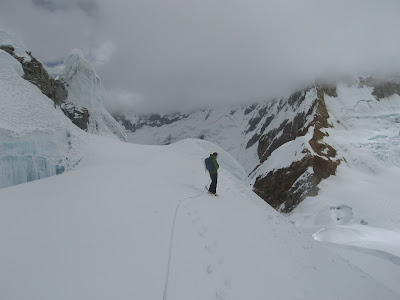I honestly thought I would suffer a lot more up Huayna Potosi, as I was having difficulty getting enough oxygen into my lungs at 5,300m on Nevado Pisco. The conditions on Huayna Potosi were great, however, and I didn't suffer (perhaps to my disappointment...), feeling great during the entire climb. I think I've gotten in much better shape since Pisco, too, and gotten more adjusted to the +3,700m altitutde. On the way down, I offered to carry some of my fellow climber's gear, almost feeling sad that the mountain hadn't pushed me to my limits -- and that I hadn't "touched the void."
It's a relaxing 3 hour hike up to the refuge from the base camp, which includes a lovely refuge complete with hot showers and a fireplace. I think it can easily be done in 2 hours, but our guides seemed to insist that we were all whimps and needed frequent breaks. We didn't have any donkeys, which I suppose made it a much more "pure" climb, and I carried all my equipment -- plastic boots, two ice axes (only one was necessary, however), crampons, harness, three liters of water -- up to the refuge at 5,300m.
 At the refuge at 5,300m, the night before the ascent. The view was incredible.
At the refuge at 5,300m, the night before the ascent. The view was incredible.At the refuge on the glacier, we melt some snow for a warm tea before setting off at 3 am for the summit. Two guides accompanied two Israelis, an Englishwoman, and myself. We heard it was a four to five hour climb, and we managed it in almost exactly four hours, summiting at 7:08. The climb wasn't technical at all: the only two parts that necessitated ice axe usage were a 50 degree ice wall at about 5,700m, and then a narrow ridge about 30m before the summit. Unfortunately for me, a lefty, this required using the ice axe in my right hand. Although my right arm is more or less as strong as my left, it was a bit like trying to play tennis with my right arm -- each ice axe strike was a pathetic mis-hit on the ice.
 Ok, so the two Israelis were smart enough to make summit posters before the climb, and I had to take a picture with one of them. This one apparently says "I love you mom" (I love you mom! And happy birthday tomorrow!) in Hebrew. Tal, the one who made this poster, is to my left. Tal didn't seem to be in great shape, but was definitely determined: he had been sick for the past day and vomited five times on the climb.
Ok, so the two Israelis were smart enough to make summit posters before the climb, and I had to take a picture with one of them. This one apparently says "I love you mom" (I love you mom! And happy birthday tomorrow!) in Hebrew. Tal, the one who made this poster, is to my left. Tal didn't seem to be in great shape, but was definitely determined: he had been sick for the past day and vomited five times on the climb.Don't worry, this won't become a mountain climbing blog, as I'm about to head out of the Andes and into the eastern part of South America -- Paraguay.









 At the summit. Visibility is very poor. Can't seem to rotate images in blogger or on the computer.
At the summit. Visibility is very poor. Can't seem to rotate images in blogger or on the computer.
 At the edge of the glacier; off with the crampons. Happy.
At the edge of the glacier; off with the crampons. Happy.
















